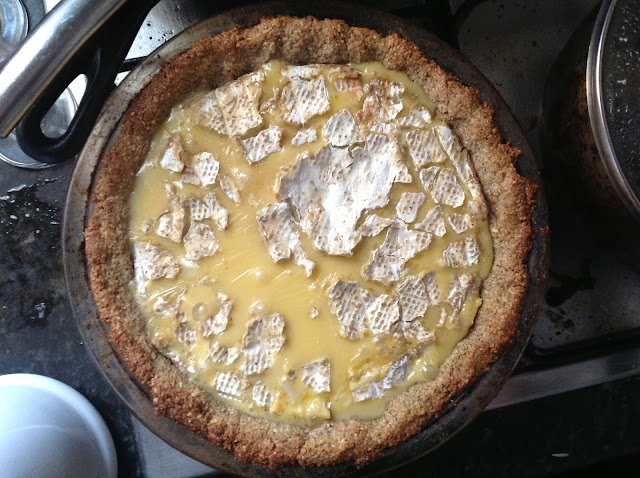In adoration of all things fatty and delicious, for they make us happy and fully alive...
Monday, 9 September 2013
Organic Brie in Sprouted Buckwheat/Almond Crust Pie
This idea came to me in a flash of perverse inspiration. It is incredibly simple and seems so obvious that I have trouble believing that I could have invented it....but I have never seen it anywhere but in my own kitchen....
The quality of the Brie cheese is obviously crucial. I used a rich creamy organic handmade large round from Adelaide Hills Udder Delights (featured on my favourite fatty products page).
The crust uses Living Intentions organic Sprouted Buckwheat/Almond flour, mixed with organic NZ pastured butter and one pastured free-range egg.
This does NOT make a kneadable dough. It makes a moist lump that can be pressed into a butter-greased ceramic pie dish. Once it is pressed into the dish, I moisten the outer edges of the dough with a little water, then let it bake in hot oven for just a few minutes to dry out the crust on the base. Sprouted non-cereal flour does not actually need to cook in the way cereal flours do, so it is more a matter of drying it enough to lose the stickiness of the dough.
The Brie is then placed in the middle. The dish ideally should be only slightly bigger in diameter, but if the Brie does not come all the way to the edges of the crust, it can be pressed down a little to spread it (especially if it is a nice fat Brie).
Leave this in oven until the Brie starts to look shiny and runny, and the pie crust edges have browned just a little for that nice toasted flavour. Then whip it out and let it rest a few minutes. You will need a knife to slice it and a spatula to scoop it out. It will fall apart a bit on lifting the slices, but who cares....?
I serve it with fresh organic unwashed rocket over which I drizzle a good fruity organic olive oil.
This also works with Camembert cheese, but I believe Brie is higher in the ever elusive and oh-so beneficial vitamin K2...
Below is a half-devoured slice taken when I paused for a moment and then thought it looked kind of nice even in this state. Be warned. This is very rich and if someone is not accustomed to the lipidy life or to the magnificence of a good festy cheese, they may struggle to finish a slice....
This dish will keep in the fridge for a few days and can be gently rewarmed. I am inclined to eat it on the first melt though, since these sort of cheeses can start to fall apart in their molecular structure on multiple heatings, and you may end up with an oily residue alongside a grainier cheese mass. This is inoffensive but hardly the nirvana of the original delight.
Subscribe to:
Post Comments (Atom)


No comments:
Post a Comment